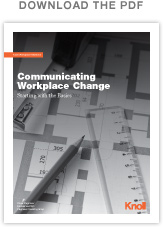
Comprehensive Communication Plans Accelerate Acceptance of Change
Many workplace transformation teams struggle with how to begin the development of communication regarding imminent changes in the organization’s work environment. A common fear is that because all of the decisions have not yet been made, it’s too early to begin sharing any details of changes being planned. Hesitation to begin the communication process may stem from a concern that the messages will be met with resistance, and that the team is not equipped to appropriately manage that push-back. There may also be apprehension that once the first message is broadcast, that ongoing communication will be expected by the workforce, requiring additional internal resources that are not available to support the project.
Developing a comprehensive communication plan involves looking beyond that first announcement and plotting out the required sequence of messaging for the transformation process. Consider the plan a living document that can be modified on an ongoing basis if there is a delay in the renovation schedule, if you need to address new areas of resistance that surface, or if unforeseen situations impact the project.
A solid communication plan will articulate how the shifts in the work environment align with other organizational changes. For example, the new workplace strategy may support the company’s real estate goal to consolidate dispersed locations across town into one building. That same strategy, in conjunction with the plan for an open, shared-space environment that encourages mentoring and knowledge exchange, could support human resource’s objective of improving collaboration amongst the four generations in the workplace. Exemplary messaging “connects the dots” for the audience and accelerates acceptance of change. Educating the workforce on the business case for change makes it more difficult for resistance to persist.
Where Do We Begin?
Where do we begin in creating the communications plan? The best starting point is to begin with the basics, asking yourself “Who, Why, What, When, and How?” Let’s focus on how each of these aspects fits into the structure of a comprehensive communications plan.
Who?
The “who” of the communications plan refers to the audience for whom the message is intended. Various groups with which you may need to share information may include a steering committee, business unit leaders, employees who have been identified to participate in a pilot program or functional department heads.
In a comprehensive communications plan, “who” also refers to the individual or team responsible for the task. If your internal corporate communications staff is spread thin, an external consultant may be responsible for developing the content of workplace change communications. Who, internally, is that message coming from? In general, the higher in the organizational hierarchy the “author” is, the more credibility the message will have and the greater the sense of urgency it can create.
Why?
Have you clearly identified the purpose of this message? What is your objective? What is it that you’re trying to accomplish—selling executives on the investment in the new work environment? Educating managers on the new flex work policies that will support the alternative workplace strategy? Inviting employees to visit the furniture mock ups and fill out a feedback form?
Honesty is the best policy. The tone of message should not sound like an apology, articulating that “unfortunately, managers will be losing their private offices.” Instead, begin the communication piece by focusing on the benefits the new work environment will bring and how those advantages will be achieved. Helping readers understand the business drivers of change can draw their attention to organizational requirements, rather than focusing on personal desires. Details you know will be resisted don’t have to be withheld. However, starting the message by focusing on the positive will ensure that the negative is not the first thing the reader will see.
What?
The specific message you are sharing is the “what” of the communication plan. Are you inviting managers to a round table discussion about supervising employees who will begin working remotely? Are you trying to encourage 100% participation in the assessments that will identify the candidates suitable for the flexible work program? Is your goal to solicit volunteers to serve on the Employee Engagement Committee? These examples fall in the category of “what” that message must articulate.
Be consistent with the language used in messaging. There are dozens of terms to describe the evolving work environment and new ways of working—agile work environments, telework, flexwork, hoteling, connected workforce, distributed workplace, free address, reverse hoteling, hot desking, etc. Now is not the time to show off just how many different ways you can describe the workplace strategy and how people will have to adapt their work styles. Pick a term and stick with it.
When?
Proactively educating the workforce allows you to shape and share the appropriate message before the workforce develops its own messaging in the form of rumors that will fuel greater resistance and damage employee trust in the organization.
Timing is everything. Identifying a “trigger” for a particular communication piece can make the development of a communications timeline much easier. For example, you may not want to send an email blast to individual contributors with newly-developed FAQs until after the CEO briefs directors at the monthly executive meeting. The review becomes the trigger in this particular case. Include mention of key triggers in your plan to establish milestones in the communication process.
How?
In your plan, this refers to the events or activities through which the message will be shared, or the method of communication. If your organization’s culture is “high touch,” then an important message might best be communicated at a “town hall” meeting. For critical communication for which speed is a necessity, then an enterprise-wide email may make the most sense. Think of your organization’s culture and how people have responded to different modes of communication. This may provide a guideline for the appropriate way to plan the delivery of the message. But don’t be afraid to challenge the way the organization has typically delivered communiqués—sometimes the unconventional can really get people’s attention!
Communication is a two-way process. If your organization simply shares details of the forthcoming changes with the workforce, but does not provide a mechanism for people to share feedback, then employees may perceive change as being pushed on them, rather than feel that they are being given a voice to influence change. Employees need to feel that their opinions count and that they are being heard.
Characteristics of Successful Workplace Change Communications
In summary, organizations that have gained enterprise-wide acceptance of workplace transformation have a number of common characteristics. Five “must include” communication elements can contribute to the success of your evolving workplace:
-
A proactive approach to communication
-
Honest tone in messaging
-
Consistent language and terms
-
Message content that “connects the dots” for employees
-
Ongoing communications
Navigating the waters of a workplace transformation can be an intimidating endeavor, but by having a vision of an overarching message you want to communicate, tailoring that message to the proper stakeholders, and following a proven communication process, you can reduce resistance to the changes your organization is implementing.
DOWNLOAD "Communicating Workplace Change" TO READ THE FULL PAPER




















